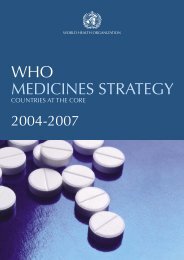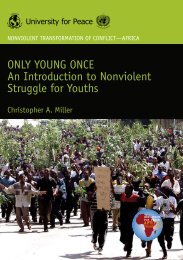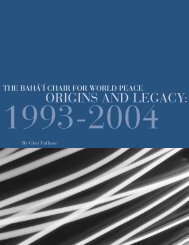environmental degradation as a cause of conflict in - Steiner Graphics
environmental degradation as a cause of conflict in - Steiner Graphics
environmental degradation as a cause of conflict in - Steiner Graphics
You also want an ePaper? Increase the reach of your titles
YUMPU automatically turns print PDFs into web optimized ePapers that Google loves.
abs. In the p<strong>as</strong>t they had been <strong>in</strong>volved <strong>in</strong> raid<strong>in</strong>g and counter-raid<strong>in</strong>g aga<strong>in</strong>st oneanother and aga<strong>in</strong>st settled farmers (see Beck 1996). It took the colonial governmentconsiderable time and effort to control them and prevent them from attack<strong>in</strong>gone another or attack<strong>in</strong>g the settled farmers (see Beck 1996).The other ecological zone is the one extend<strong>in</strong>g from the White Nile <strong>in</strong> the Sudanto Lake Chad. This belt is a rich savanna, suited for rais<strong>in</strong>g cattle and is occupied bythe Baqqara, i.e. the cattle-own<strong>in</strong>g people, who are mostly Arabs. Observers makethe po<strong>in</strong>t that nomads <strong>in</strong> this belt are <strong>in</strong>cre<strong>as</strong><strong>in</strong>gly becom<strong>in</strong>g settled farmers andonly a small number <strong>of</strong> them cont<strong>in</strong>ue to keep herd<strong>in</strong>g <strong>as</strong> a means <strong>of</strong> livelihood (seeBraukamper 2000). Darfur region h<strong>as</strong> long strips <strong>of</strong> the two ecological zones, andhence, a sizable number <strong>of</strong> its population is still nomadic.B<strong>as</strong>har (2003) found that out <strong>of</strong> the thirty-n<strong>in</strong>e major tribal <strong>conflict</strong>s that tookplace <strong>in</strong> Darfur dur<strong>in</strong>g the period 1923-2003, the nomadic groups were <strong>in</strong>volved <strong>in</strong>twenty-n<strong>in</strong>e <strong>of</strong> them, a fact which h<strong>as</strong> been confirmed by Mukhtar (<strong>in</strong> Mohamed andWadi 1998) and Takana (<strong>in</strong> Mohamed and Wadi, 1998). Violent tribal <strong>conflict</strong>s <strong>in</strong> theDarfur region, therefore, cannot be adequately expla<strong>in</strong>ed without reference be<strong>in</strong>gmade to p<strong>as</strong>toral nomadism <strong>as</strong> a mode <strong>of</strong> liv<strong>in</strong>g <strong>in</strong> the region.However, be<strong>cause</strong> Darfur is now a war-torn region, one should not jump to theconclusion that it h<strong>as</strong> always been like that and that it had no heritage <strong>of</strong> peacefulcoexistence among its different groups. In fact, the region had enjoyed anexceptionally peaceful coexistence, for at le<strong>as</strong>t the period follow<strong>in</strong>g its annexationto the rest <strong>of</strong> Sudan <strong>in</strong> 1916 and up to 1956, the end <strong>of</strong> the foreign rule. Prior tothat time and follow<strong>in</strong>g it the region h<strong>as</strong> been marred by all types <strong>of</strong> ethnic andtribal <strong>conflict</strong>. The colonial government <strong>in</strong> Darfur (1916-1956) needed to arrangefor only two conferences to resolve <strong>conflict</strong>s. The first w<strong>as</strong> <strong>in</strong> 1924 between theRizayqat cattle nomads and the D<strong>in</strong>ka, their neighbours to the south. The second,<strong>in</strong> 1932, w<strong>as</strong> between the camel nomads <strong>of</strong> northern Kord<strong>of</strong>an, the Kababish andthe Kawahla. and their neighbours <strong>in</strong> northern Darfur, the Zayyadiyya, Berti andMeidob. The conference w<strong>as</strong> held <strong>in</strong> Umm Goza<strong>in</strong>, a border area between the twoprov<strong>in</strong>ces (see B<strong>as</strong>har 2003).By contr<strong>as</strong>t, follow<strong>in</strong>g the declaration <strong>of</strong> <strong>in</strong>dependence <strong>in</strong> 1956, and up to now,<strong>in</strong>ter-group <strong>conflict</strong>s and subsequent reconciliation conferences to resolve themhave become the rule rather than the exception, result<strong>in</strong>g <strong>in</strong> an average <strong>of</strong> 1.5conferences per year. In fact, 6 reconciliation conferences were held <strong>in</strong> 1991 alone.No attempt will be made here, however, to expla<strong>in</strong> these strik<strong>in</strong>g <strong>in</strong>cre<strong>as</strong>es <strong>in</strong> thefrequency <strong>of</strong> <strong>conflict</strong>s and reconciliation conferences to resolve them. Rather Iwould refer the reader to Mohamed (2002, 2004).One ma<strong>in</strong> factor needs to be mentioned though: the philosophy <strong>of</strong> governanceh<strong>as</strong> much to do with the phenomenon. Notwithstand<strong>in</strong>g the fact that the British,who ruled the Sudan (1898-1956) were colonizers <strong>in</strong> the first place, and they were69











